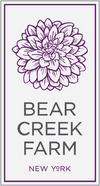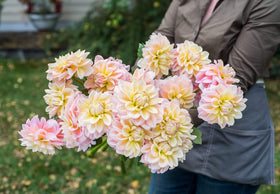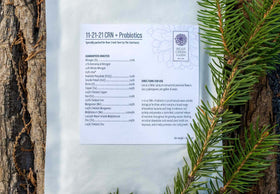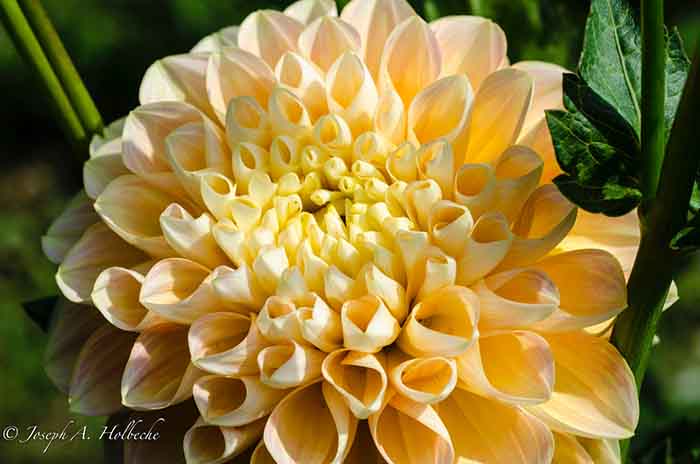As is the case with many startups, an adventurous dose of passion ignited Bear Creek Farm. Quite simply I fell in love with my husband, I fell in love with dahlias, and soon we had a farm. This happened very quickly, after my florist friend informed me that the Hudson Valley was too far to travel for my wedding flowers.
“What flowers grow that month?” I asked. After naming a few, “dahlias” rolled off his tongue. He showed me pictures of the elegant beauties. I planted 100, which upon viewing he called the most beautiful he had ever seen. He insisted I sell them, which I had never considered.
Growing dahlias? Giant dahlias for sale? Maybe this is why I had hung on to this property for so long...
Cue the violins’ silence. This is where all emotionalism ends, and right where it must when starting any business, but especially a farm. You have to love what you do, yes, but passion alone will not create success. My background in creating multi-million dollar products leads me to approach farming in a very different way.
I was accustomed to big business so my goal from the gate was to create a 7-figure business. So there was the dilemma: how could I get there with small-scale farming? Fortunately, I understood from the start the inherent strength of the dahlia business; it could be a year-round Internet enterprise - therefore national business - because it propagates its own tubers. This offered greater potential than most cut flower businesses. But the cost of entry was clear. One had to be known as the best flower before people would care about our dahlias. Was there potential for innovation? Here so close to NYC, one of the world’s toughest flower markets, could we create a superior dahlia in order to become the best in our field?
As much as I loved dahlias, I really needed to learn about farming. We followed my standard protocol for innovation projects: we dug deep into existing research. We chewed on figures that led us to an inevitable conclusion.
- In 2018, commercial cut-flower production revenue at $30K to $35K an acre is considered excellent according to books I read
- Once a farm is fully capitalized, net should be about 30%-60% of gross
- An acre can handle at least 6000 dahlias (calculation 18” apart by row space of 60” for tractor width, so 7 sq. ft. per dahlia)
- Max someone can cut is 200 dahlias/hr. (giants need more time)
- So, if you cut half a one acre field every other day and only half of the flowers are ready, that is 1500 flowers to be cut or 7.5 hours for one person, which leaves no time for conditioning, pack-out, marketing, etc.
- Thus at least one employee is needed
- So at $15,000 net, a farm cannot make money
- Not to mention capital start-up costs of cold storage/storage for tubers/ fencing to keep deer out/tractor, etc.
The figures had spoken. Unless we could get our field value up, the business was a nonstarter. We could never make back our start-up costs or have money for marketing to be a national seller of dahlia bulbs without finding a way to make a splash.
From wholesalers and florists alike, we found out there were enormous problems with dahlias: they didn’t ship well, they only lasted three days or so, and there were precious few giant dahlias available (mostly related to the difficulty of shipping, but also some growing issues). We studied how other growers were packing them, and how they were being stored.
We read all the research we could find on dahlias. There is not a lot because small growers in the US mostly commercialize them. However, two studies we found indicated that dahlias drink through the whole stem, not just their hollow bottoms. This made absolute sense to us. Most growers were packing dahlias with 12” or maybe 15” stems, particularly the giants, so that they would not be floppy. This was actually shortening their lifespan because they would get less water than they needed. Aesthetically, big heads look less pretty on short stems.

Alternately, we created longer, more stunning flower stems that arrive in equally grander packaging. We cut all our stems to 24” and use packaging that is 30” tall.
In addition, we developed fertilization techniques to ensure the strongest possible stems. We also defined a propriety conditioning process. Our tall-stemmed beauties not only last longer but also look far more elegant.
We took exception to the common notion that dahlias should share the roses’ cooler. That temperature is excessively cold for this tropical flower. We suggested a permanent move to tropical coolers, which lengthens the lifespan of the dahlias.
As for restaurants, we learned that dahlias can be set out all day and, if at night placed back in the cooler, they will revive and be good as new as long as they do not remain in that cooler more than overnight.
By creating a premium dahlia with a proprietary conditioning process, better packaging and more complete instructions on how to maintain them, we were fortunate to have been noticed quickly and voted Best Dahlias of New York by New York Magazine. Our per-acre revenue is more than triple that of the one I learned about for cut flowers. Moreover, this is before tuber sales.
Are there other ways to increase revenue? Of course, wedding sales are one. However, this is quite labor-intensive and there are large marketing costs associated with it. Being so close to NYC, it would also be difficult to compete with the marvelous and talented floral designers, many of whom are our customers.
Our objective has always been to build a million-dollar business. This is not an easy task in the sunniest economic times. We were fully prepared to face down three years to break even and the ups and downs and reshifting of ideas of any business starting out, learning, and involved in innovation. Yet, we have met some amazing milestones. We have no doubt our goal is possible. This is the journey we will be sharing with you.
Funny thing, I still feel passionate about dahlias.




